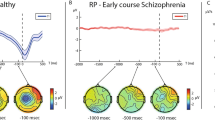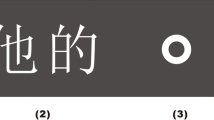Abstract
Findings on depressive patients indicate that depressives have electrophysiological characteristics similar to those of schizophrenics, in that they exhibit reduced Contingent Negative Variation (CNV) amplitudes and more distinct Postimperative Negative Variations (PINVs) than normal controls. In a biofeedback experiment, 8 medicated male inpatients with the DSM III-R diagnosis of “Bipolar Disorder, Depressive,” and “Major Depression” demonstrated no impairment in the self-regulation of Slow Cortical Potentials (SCP) in comparison to schizophrenics in terms of increasing and suppressing negativity. Continuous visual SCP feedback is presented to the patient as a horizontally moving rocket in a video game format. The direction changes of the rocket represented SCP changes at each point in time, recorded by the central EEG (based on the pretrial baseline). Depressives demonstrated SCP self-regulation across 20 sessions, although with many between-and-within variations. The 8 male controls were unable to regulate their SCPs across 5 sessions. This result contradicts other findings of our laboratory on normal controls. Motivational factors and insufficient operant reinforcement (financial reward) may have facilitated this effect.
Similar content being viewed by others
References
Abraham, P., & McCallum, W. C. (1976). The CNV and its relation to specific psychiatric syndromes. In W. C. McCallum & J. R. Knott (Eds.),The responsive brain (pp. 144–149). Bristol: Wright.
Bolz, J., & Giedke, H. (1980). Controllability of an aversive stimulus in depressed patients and healthy controls: A study using slow brain potentials.Biological Psychiatry, 15 441–452.
Clavarie, B., Brun, A., Nizard, A., Brenot, P. & Paty, J. (1984). Multiparametric outlines with CNV: Application to depressive syndromes. In R. Karrer, J. Cohen, & P. Tueting (Eds.),Brain and information. Annals of the New York Academy of Science, 425 556–564.
Elbert, T. (in press). Slow cortical potentials reflect the regulation of cortical excitability. In W. C. McCallum (Ed.),Slow potential changes in the human brain. New York: Plenum.
Elbert, T., Rockstroh, B., Lutzenberger, W., & Birbaumer, N. (1980). Biofeedback of slow cortical potentials. I.Electroencephalography and Clinical Neurophysiology, 48 293–301.
Elbert, T., Lutzenberger, W., Rockstroh, B., & Birbaumer, N. (1983). When regulation of slow brain potentials fails — A contribution to the psychophysiology of perceptual aberration and anhedonia. In C. Perris, D. Kemali, & M. Koukkou-Lehmann (Eds.),Clinical neurophysiological aspects of psychopathological conditions (pp. 99–106). Basel: Karger.
Elton, M., DeJong, R., & Ferstl, R. (1980). The CNV in reactive depressives and normals.Biological Psychology, 11 28.
Endicott, J., Spitzer, R. L., Fleiss, J. L., & Cohen, J. (1976). The Global Assessment Scale. A procedure for measuring overall severity of psychiatric disturbance.Archives of General Psychiatry, 33 766–771.
Hamilton, M. (1960). A rating scale for depression.Journal of Neurology, Neurosurgery and Psychiatry, 23 56–62.
Kathmann, N., Jonitz, L., & Engel, R. R. (1990). Cognitive determinants of the postimperative negative variation.Psychophysiology, 27 256–263.
Lubar, J. F., & Lubar, J. (1984). Electroencephalographic biofeedback of SMR and beta for the treatment of attention deficit disorders in a clinical setting.Biofeedback and Self-Regulation, 9 1–23.
McCallum, W. C. (1988). Potentials related to expectancy, preparation and motor activity. In T. W. Picton (Ed.),Human event-related potentials — Handbook of electroencephalography and clinical neurophysiology, Vol. 3 (pp. 427–453). Amsterdam: Elsevier.
Meehl, P. (1962). Schizotoxia, schizotypy, schizophrenia.American Psychologist, 17 827–838.
Oldfield, R. C. (1971). The assessment and analysis of handedness: The Edinburgh Inventory.Neuropsychologia, 9 97–113.
Overall, D. E., & Gorham, D. E. (1962). The Brief Psychiatric Rating Scale.Psychological Reports, 10 799–812.
Pierson, A., Ragot, R., Ripoche, A., & Lesevre, N. (1987). Electrophysiological changes elicited by auditory stimuli given a positive or negative value: A study comparing anhedonic with hedonic subjects.International Journal of Psychophysiology, 5 107–123.
Rizzo, P. A., Amabile, G., Caporali, M., Pierelli, F., Spadoro, M., Zanasi, M., & Morocutti, C. (1979). A longitudinal CNV study in a group of five bipolar cyclothymic patients.Biological Psychiatry, 14 581–586.
Roberts, L., Birbaumer, N., Lutzenberger, W., Elbert, T., & Rockstroh, B. (1989). Self-report during feedback regulation of slow cortical potentials.Psychophysiology, 26 392–403.
Rockstroh, B., Elbert, T., Canavan, A., Lutzenberger, W., & Birbaumer, N. (1989).Slow cortical potentials and behaviour (2nd ed.). Baltimore: Urban & Schwarzenberg.
Roth, W. T., Duncan, C. C., Pfefferbaum, A., & Timsit-Berthier, M. (1986). Applications of cognitive ERPs in psychiatric patients. In W. C. McCallum, R. Zappoli, & F. Denoth (Eds.),Cerebral psychophysiology (pp. 419–438). Amsterdam: Elsevier.
Sartory, G. (1986). The contingent negative variation (CNV) in psychiatric states. In I. Martin & D. Papakostopoulos (Eds.),Clinical and experimental neuropsychology (pp. 286–311). London: Croom Helm.
Schneider, F., Rockstroh, B., Heimann, H., Lutzenberger, W., Mattes, R., Elbert, T., Birbaumer, N., & Bartels, M. (1992). Self-regulation of slow cortical potentials in psychiatric patients. Schizophrenia.Biofeedback and Self-Regulation, 17 (4).
Schneider, F., Elbert, T., Heimann, H., Welker, A., Stetter, F., Mattes, R., Birbaumer, N., & Mann, K. (in press). Self-regulation of slow cortical potentials in psychiatric patients. Alcohol dependency.Biofeedback and Self-Regulation.
Small, J. G., & Small, I. F. (1971). CNV correlations with psychiatric diagnosis.Archives of General Psychiatry, 25 550–554.
Timsit-Berthier, M., Delaunoy, J., Koninckx, N., & Rousseau, J. (1973). Slow potential changes in psychology. I. Contingent negative variation.Electroencephalography and Clinical Neurophysiology, 35 355–361.
Timsit-Berthier, M., Mantanus, H., Marissiaux, P., Ansseau, M., Doumont, A., Geenen, V., & Legros, J. (1986). CNV and dopamine receptor reactivity: Correlations with the apomorphine test. In W. C. McCallum, R. Zappoli, & F. Denoth (Eds.),Cerebral psychophysiology: Studies in event-related potentials (pp. 403–405). Amsterdam: Elsevier.
Timsit-Berthier, M., Mantanus, H., Ansseau, M., Devoitille, J.-M., Dal Mas, A., & Legros, J.-J (1987). Contingent negative variation in major depressive patients. In R. Johnson Jr., J. W. Rohrbaugh & R. Parasuraman (Eds.),Current trends in event-related potential research (pp. 762–771). Amsterdam: Elsevier.
Wittchen, H.-U. Zaudig, M., Schramm, E., Spengler, P., Mombour, W., Klug, J., & Horn, R. (1987).Strukturiertes klinisches Interview für DSM-III-R (Testversion). Weinheim: Beltz.
Author information
Authors and Affiliations
Additional information
The authors are grateful to Waldemar Himer, Thomas Elbert, and Brigitte Rockstroh for their theoretical and technical support. Furthermore, we would like to thank Monika Wende and Gudrun Renz for their help during the experimental sessions and their assistance in evaluating the data. We would also like to thank Ilse M. Zalaman for her assistance in the preparation of this manuscript. Research was supported by the Bundesminister für Forschung und Technologie, Germany and the Deutsche Forschungsgemeinschaft.
Rights and permissions
About this article
Cite this article
Schneider, F., Heimann, H., Mattes, R. et al. Self-regulation of slow cortical potentials in psychiatric patients: Depression. Biofeedback and Self-Regulation 17, 203–214 (1992). https://doi.org/10.1007/BF01000403
Issue Date:
DOI: https://doi.org/10.1007/BF01000403




